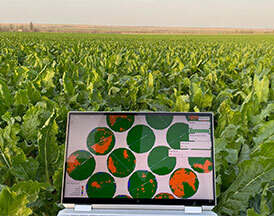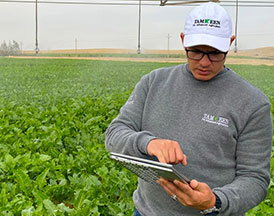

We use existing and new technology
We use three components to reach our goals
Measurements of different thermal satellites are combined into a daily leaf temperature product from which evaporative cooling, sap-flow, and root zone soil moisture conditions are inferred using advanced remote sensing algorithms. The soil moisture from today – in conjunction with weather forecasts for tomorrow – will assess the need to irrigate during the next 24 hours. IrriWatch is the only company using the 4th generation SEBAL model as the core engine. Every field is divided into pixels of 100 m2 each. For each hectare (10,000 m2), 100 pixels will be consulted to decide on required irrigation actions for tomorrow. Irrigation is advised if 20 to 40 % of the pixels have soil moisture that is lower than the so-called critical soil moisture (i.e. threshold value at which crop water stress is triggered)
Advice with a certain minimum and maximum amount of irrigation water is provided via the IrriWatch App that is freely downloadable from the PlayStore and the AppStore. Fields requiring water will be highlighted on a map. In this case irrigation is not required, the remaining period until the next irrigation is provided. For orders with less than 25 fields, each field will have a personalized Irrigation Bulletin. The priority of the fields to be irrigated will be ranked every day so that irrigation teams in the field better know where to start their job after checking the App at the breakfast table.
The service includes also a web application for your tablet or laptop for additional diagnostic analysis. We provide a spatial viewer for commercial users who manage farms in different parts of a given country (or in different countries). This viewer is a monitor of the daily irrigation processes of all fields. Whether you call this a “monitor” or “control room” is your decision. We offer you the technology to oversee all fields you are responsible for. Areas of particular interest can be seamlessly zoomed in and out. This can be especially valuable in irrigation water supply systems that lack adequate and reliable flow measurement capability. Water supply agencies can monitor the equitability of water distribution and water productivity using unbiased information from IrriWatch.







